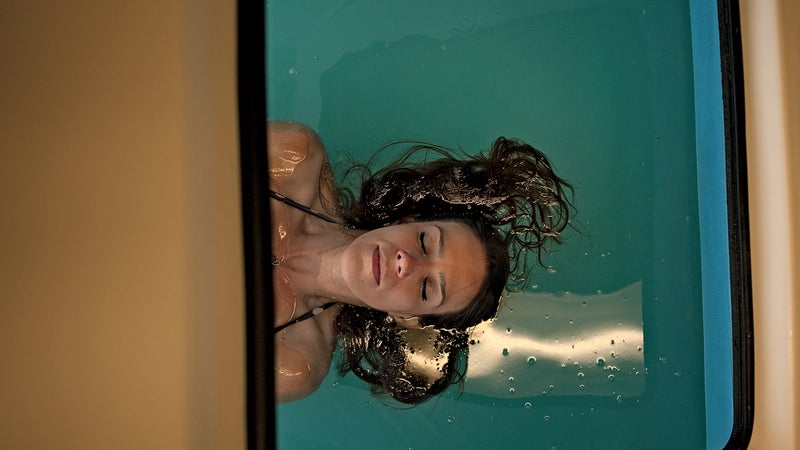Last February, 33-year-old cyclist Evelyn Stevens took on the women’s hour record at a velodrome in Colorado Springs. Stevens, an investment banker turned professional athlete who raced in the 2012 Olympics, had years of experience riding on the roads and was used to the cerebral effort required by elite-level performance. But a rider’s psychological control is pushed to the limits racing against the clock on a track: there are no power meters allowed, hardly any sounds, and no other riders. The attempt was “a highlighted mental task,” Stevens says. “You’re by yourself. If you fail, you fail alone.”
Several months earlier, Stevens’s husband had seen an article about , the Golden State Warriors point guard and reigning league MVP. Curry had become fascinated with sensory-deprivation tanks. Floaters step inside an eight-by-five-foot capsule partly filled with body-temperature salt water and are deprived of sight, sound, and touch. The practice is described as like drifting in outer space and is said to induce a powerful meditative experience. “When I get in the tank,” Curry , “it’s just me and my thoughts for an hour, playing Russian roulette of the mind.”
Curry’s preferred float spa is around the corner from Stevens’s home in San Francisco, and as she trained for the hour record, she made regular visits. “Often,” she says, “when you suffer—which is cycling—you think, I just want to be done with it.” The more time Stevens spent in the tank, the more present she became on hard rides. “Now I want to be there for the effort so I can get better at doing it.” In her hour attempt, Stevens made it 29.81 miles, breaking the record by nearly a mile.
If psychological training is the next big thing for elite athletes, floating is right on the cutting edge—even if it isn’t exactly new. Neuropsychologist John C. Lilly began experimenting with sensory-deprivation tanks in the 1950s, and in the decades following, a wide body of research examined whether floating could be used to treat a variety of psychological disorders. In the 1980s, Peter Suedfeld, a psychologist at the University of British Columbia, found that isolation tanks improved athletes’ performance in basketball, tennis, and target shooting, possibly by helping them tune out distractions. “In modern society, we are subject to very high levels of stimuli, both physical and social,” Suedfeld says. “I think the levels people are bombarded by are higher than we have evolved to deal with.” Understimulation, Suedfeld says, gives people a chance to relax and process what’s happening internally.

Floating fell out of favor in the late 1980s, in part due to the AIDS crisis, when people feared that the water in the tanks would transmit the disease. Thirty years later, however, as scientists are getting a more precise idea of how it may affect the brain, the practice is having a mainstream resurgence, with athletes leading the way.
The evangelism of Ultimate Fighting championship commentator Joe Rogan has made floating popular among mixed martial artists. It has also gained serious traction with several professional sports teams: the New England Patriots reportedly purchased two tanks, and several members of the Dallas Mavericks float regularly. There are now more than 300 studios in the U.S.
Psychiatrist Martin Paulus, the president and scientific director at the Laureate Institute in Tulsa, Oklahoma, which researches psychiatric disorders, believes that floating reduces sensitivity to emotional stimuli in the amygdala, the area of the brain involved in fear and stress responses. “The amygdala is very reactive to things coming in from the outside—somebody looks at you funny, or you hear a sound that’s scary,” Paulus says. That kind of stress is good when the guy looking at you is about to steal your wallet, but elsewhere it’s counterproductive. Paulus has theorized that athletes with less reactive amygdalas may be better at thinking clearly when they start hurting or things go wrong. “It helps you be more in tune with what you need to do,” he says.
Exactly how much floating affects the amygdala is still unclear. “The research is in its early stages,” Paulus says. Laureate Institute researcher Justin Feinstein will soon publish two fMRI studies that look at changes to the amygdala after spending time in a tank. The initial data suggests that floating reduces emotional reactivity. Both studies are awaiting peer review.
Nor has anyone figured out when it’s most beneficial to float, or how often. Stevens floated for 60 minutes once a week in preparation for the hour record, while Casey Smith, head trainer for the Mavericks, says that his players mostly use it to relax after games or to decompress from a long stretch on the road. “There is evidence that floating, whatever it does, lasts beyond the float itself,” Paulus says. Whether that means athletes should hit the tank daily, weekly, or monthly is anybody’s guess.
For Stevens, floating wasn’t primarily about the hour record or even bike racing. “It’s always interesting where your mind goes,” she says. “One of the things I’ve learned from my sports psychologist is that I’m not going to stop the crazy thoughts that come into my head. It’s more, ‘OK, you have them, let it go by. Don’t hold on.’ Floating is a great way to practice that.”
Meditating Versus Floating
Both appear to mellow out areas in the brain that react to scary or exciting stimuli, which may help athletes make better decisions under stress. But there are differences. Scientists studying meditation have seen changes in the insular cortex and the ventral anterior cingulate—places that, psychiatrist Martin Paulus says, “keep a tab on the amygdala,” which is responsible for stress responses. Floating, in contrast, may reduce activity in the amygdala itself. For people who often feel overstimulated, floating may be more effective. If you get caught in circular thinking, meditation might be the better choice. Norman Farb, a psychologist who studies meditation at the University of Toronto-Mississauga, says that while both techniques can be helpful for stress management, there’s one big advantage that sitting has over floating: “Meditation is a bit more portable.”


